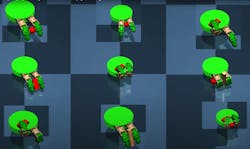Detachable Hand Extends Robotic Arm’s Reach
What you'll learn:
- Introduction to EPFL's robotic arm and detachable hand.
- How the robotic hand was developed.
- How the hand can grasp and carry objects.
Researchers at EPFL's (École Polytechnique Fédérale de Lausanne) LASA (Learning Algorithms and Systems Laboratory) robotics lab have designed a robotic arm that can detach its hand to grasp objects out of its reach.
Due to some robotic arms being large and heavy, such as those found in manufacturing plants, they’re typically permanently attached to floors or elevated tables, which limits their reach. To overcome that limitation, the researchers designed a robotic hand that can detach from the arm, go beyond its confined space, and grasp a wider range of objects.
Robotic hands are typically designed for a single purpose, which is to grasp and hold objects. To develop one that can perform those tasks and move independently from the robotic arm, the researchers generated and refined a basic design via a genetic algorithm based on biological evolution and the MuJoCo physics simulator (see figure), which tests each design iteration.
"The deep-learning model has significantly advanced dexterous manipulation techniques for multi-fingered hand grasping," stated the researchers. "However, the contact information-guided grasping in cluttered environments remains largely underexplored."
The algorithm and simulations eventually settled on a design that mimics the human hand. It comes complete with all five fingers and magnetic connectors on the wrist that allow the hand to detach from the robotic arm. Reattaching the hand is a bit different, using the magnets in the wrist to align with the hand while a screw extends to lock it in place.
Unlike human hands, the robotic counterpart's fingers can bend in both directions, allowing it to use some fingers for grasping objects and the others to act like legs and move the objects. The design also expands the robotic arm's features. Thus, it’s able it to lift more than one object at the same time without needing to twist or reposition the arm.
The entire platform is controlled manually in the video above. However, the researchers said they have a fully autonomous version working in the lab. They recently presented the robotic arm at the International Conference on Robotics and Automation (ICRA) held last month in Rotterdam, Netherlands.
About the Author
Cabe Atwell
Technology Editor, Electronic Design
Cabe is a Technology Editor for Electronic Design.
Engineer, Machinist, Maker, Writer. A graduate Electrical Engineer actively plying his expertise in the industry and at his company, Gunhead. When not designing/building, he creates a steady torrent of projects and content in the media world. Many of his projects and articles are online at element14 & SolidSmack, industry-focused work at EETimes & EDN, and offbeat articles at Make Magazine. Currently, you can find him hosting webinars and contributing to Electronic Design and Machine Design.
Cabe is an electrical engineer, design consultant and author with 25 years’ experience. His most recent book is “Essential 555 IC: Design, Configure, and Create Clever Circuits”
Cabe writes the Engineering on Friday blog on Electronic Design.


